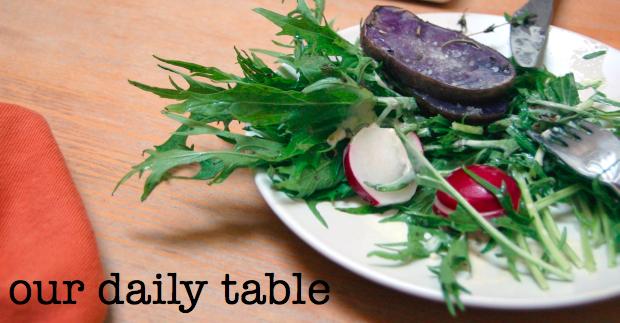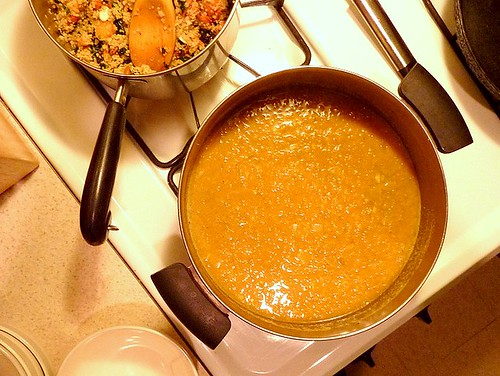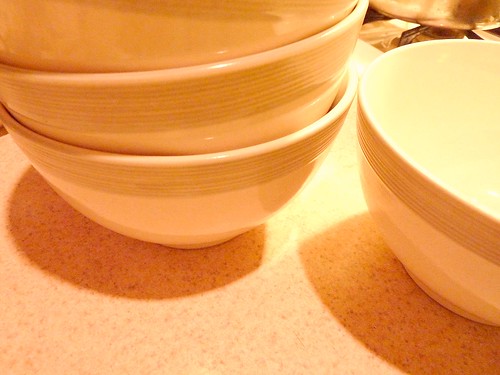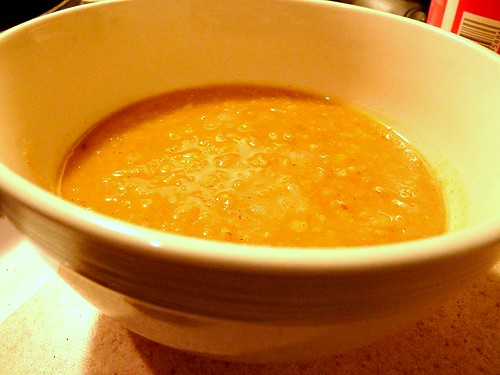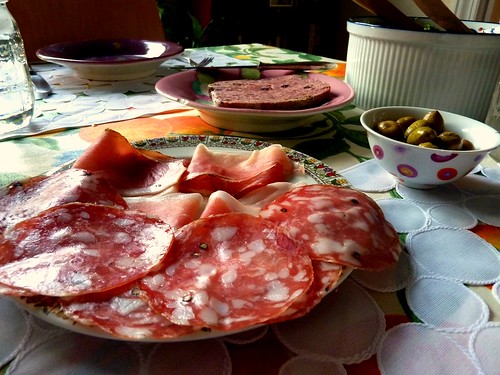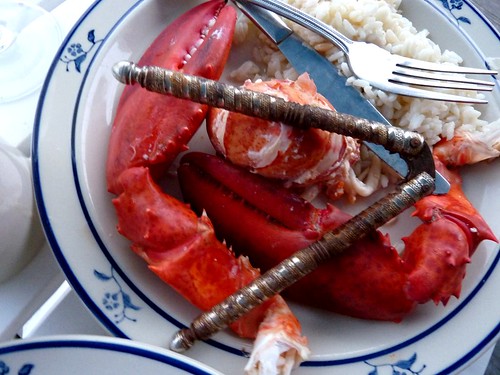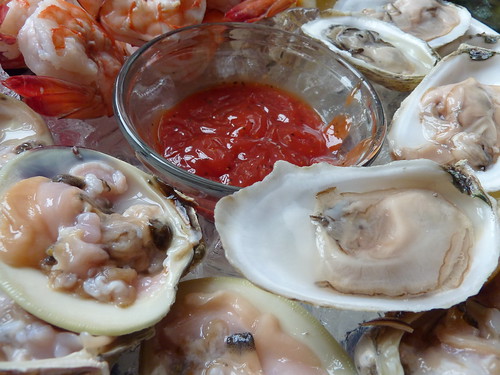It's not that I tend to be late; it's that I like to take my time. The way I see it, so many aspects of our lives require hustle, when I can I prefer to dilly-dally. Putz, if you will. I do not look on this as wasteful, or unproductive. On the contrary, I think putzing is necessary in order to hear the voice inside, the only one, that in the end, really matters. And so, after a long holiday season and a rather abrupt move in the midst of a snow storm, I finally took some time, in the fleeting days of January, to take stock of the past year and set some goals for the coming one. Of course, most of these are private, although as they play out you're likely to hear whispers of them here. But a few of them -- the food-related ones -- I wanted to share.
This year, I want to be here more, because I like it here, and frankly, so few things are completely mine creatively. I want to continue to learn about food, but I also want to turn my attention away from what seems overly excessive, or overly indulgent, or overly privileged. Not that I don't like those things, but they're awfully well-represented. I want to think more about balance and education, and I want to write more about those things, but I also just want to write more in general. I have a more immediate goal, and that is to start cooking with spices. It probably sounds easier that it is, at least to me it does. I mostly work with salt and pepper and nutmeg and often red pepper and dry and fresh herbs. My spice cabinet is full of lots of other things, powders with "exotic" names like Nigerian cayenne, white pepper and turmeric. I've cooked with all of them, but often with mixed-results. So, spices.
A dish that's been in pretty steady rotation lately at my house is a simple dahl (also spelled daal, dal, or dhal). Dahl is a healthy and hearty soup, or stew, made from beans, peas or lentils. Maybe you've had a version of it at an Indian restaurant. When I have it's often yellow in color, and served at the beginning of the meal. Dahl is found in Bangladeshi, Indian, Nepali, Pakistani and Sri Lankan cuisines, and it is a good source of protein if, like me, you eat little or no meat. I found a basic recipe for masoor dahl, Indian dahl made with red lentils (masoor is a type of lentil), online. After several takes, all of which were delicious but varied slightly due to ingredients I had on hand, I found my preferred balance of spices. Dishes being well-spiced, or even spicy, is not enough. Here, balance and intention are key.
Dahl can be garnished in a number of ways and served with rice or bread, such as naan or roti. I finished mine with a dollop of Greek yogurt and a thick piece of sour herb bread (to mop up every last drop).
Simple spicy masoor dahl.
1 cup masoor (or red) lentils, rinsed and picked through
4 cups water, or stock
1 medium white onion, finely chopped
2 cloves garlic, minced
1 tablespoon grated fresh ginger (substitute 1/8 teaspoon dry ginger)
1 tablespoon grapeseed oil, or substitute
1 teaspoon cumin seed, toasted and ground
1 teaspoon fennel seed, toasted and ground
1 teaspoon salt
1 teaspoon tumeric
1/2 teaspoon Nigerian cayenne
1/4 teaspoon cinnamon
1/4 teaspoon nutmeg
7 black pepper corns, ground
2 tablespoons tomato paste (optional)
In a small-sized skillet, dry toast cumin and fennel seeds over medium-high heat until the seeds grow slightly darker in color and become deliciously fragrant (3 to 4 minutes). Move seeds to a bowl to cool. Grind when cool to touch.
In a medium-sized stock pot, heat oil on high and sauté onion until it starts to brown (approximately 7 minutes). Add garlic and ginger, and sauté for 2-3 more minutes. Add lentils and water, and bring to a boil.
Once boiling, stir in spices, and reduce flame to medium-low. Cover and simmer for 20 minutes, or until lentils are soft.
Serves 2-4.
Note: Many recipes I read called for the lentils to be brought to a boil before the other ingredients were added. I chose to slightly brown the onion to give the soup a richer flavor (they don't call caramelized onions a vegetarian's bacon for nothing). Also, some dahl recipes call for the spices to be cooked in oil before being stirred into the cooked lentils at the end. I opted to reduce my soup with the spices. It just seemed easier, and it was.
Wednesday, March 2, 2011
Thursday, June 24, 2010
Red, right, return.
Summer arrived without so much as a pause on my part. I've been busy -- with my restaurant work and freelance work, with bike rides and afternoon beers, with last-minute trips out of the city to my friend's fantastic beach house on Cape Cod. In the last month, I've cooked very little. I've been living on hummus and smoothies and tacos and oysters. Some days, I think I could live like this forever. But I know when things slow down, and I'm home long enough to consider a dinner party, this urge will change. Until it does, a picture from a lovely "uncooked" dinner at a friend's house, and some others from the Cape, where I ate oysters, and my ultimate summer indulgence: lobster. I will return here soon, with bells and whistles and stories of the sea.
Thursday, May 27, 2010
Rocking the salad roll.

I wouldn't say I had a complete breakdown on Tuesday, but I wasn't far off. Thankfully I was alone when -- a mere two hours into what I'm calling Project Salad Roll -- I muttered aloud: What the hell was I thinking? An hour later, it slipped out again. Several times. To no one in particular. Then, half an hour after that, as I was bagging up five little boxes each containing five bundles of shrimp, slaw and vermicelli, I burst: These fuckers better be worth it. Forgive me, but I'd invested nearly four hours on what I thought would be a quick snack.
When I arrived at my friend's house a bit later, I was thrilled (nay, relieved) that they still looked good. Sure, they weren't nearly as pretty as the salad rolls I've had in restaurants, and some of them were sporting holes and leaking a bit, but they tasted good. I knew this for a fact because for every half dozen I managed to wrap semi-correctly, I botched at least one, which of course had to be eaten. I thought it a miracle I actually wanted to eat more of them, but I did. They were that good: the gelatinous chew of the vermicelli next to the crunch of the julienned cucumbers; the salty meat of the shrimp dotted with a brilliantly fragrant red cabbage and carrot slaw.
True to my spirit, I'd gone rogue in my planning; what was intended to be a buffet of individually julienned vegetables, turned into a slaw that stole the show. To the cabbage and carrots, I added basil, lovage and raw shallot. At the last minute, there was some raw ginger and lime juice, rice vinegar and sesame oil. Was it too much? Had my delicate dish been compromised?
Carrying the plate from the kitchen to my friends outside, my emotions were akin to a child's on the first day of school. I was excited and a bit nervous, scared of rejection and fearful that everyone but me would be allergic to shellfish. Did I imagine the "oohs" and "aahs" as I lowered the platter to the table? My friends aren't the kind who blow smoke, of that I am certain. So when they said they were good, I believed them. When they went back for seconds, I sighed. And when one friend exclaimed excitedly that my salad rolls looked like orchids, my heart swelled. The hours spent crouched on a step stool next to my kitchen table -- bowls of warm water on both sides, scads of ingredients all around -- did not fade from memory, but almost turned fond.
Yeah, the fuckers were worth it, all right.

You'll forgive me further, I hope, for not sharing the complete salad roll recipe, because there really isn't one to share. Buy a bag of rice papers, some shrimp and vermicelli, channel some patience and experiment like mad. Some tips I found useful:
-- Be sure to soak rice papers in warm warm water. You should be able to touch it, but the water shouldn't be too cool. Change water frequently, if necessary.
-- Compose rolls themselves on the glass plate. Wet rice papers stick to cutting boards.
-- Have a spray bottle of water on hand. Composed rolls should remain damp. I misted mine, then wrapped them in plastic wrap.
-- Relax. You're going to make mistakes. That just means more chances to sample the goods!
If you feel inclined to give salad rolls a go, try using this slaw. It's an attractive and interesting way to compose an otherwise orderly dish. Besides, it makes your prep work a whole lot easier. Salad rolls, I now know, aren't meant to be easy. But no one ever said pleasure was painless.
Asian-style slaw for salad rolls
Ingredients
1 small head red cabbage
5 small carrots, peeled
1 1" piece of raw ginger, peeled
1 small shallot
1/2 cup basil
1/2 cup lovage
1/2 tablespoon sesame oil
2 tablespoons rice vinegar
Juice of 1 lime
Sea salt, to taste
Using a food processor (or mandolin, or your own little hands), shred cabbage, carrots, ginger, shallot, basil and lovage.
Whisk together sesame oil, vinegar and lime juice.
In a large bowl, mix vegetables and dressing. It will be fairly dry, that's OK. The vegetables will sweat some.
Salt to taste.
Will make roughly 30 small salad rolls, or individually serve 6-8 people.
When I arrived at my friend's house a bit later, I was thrilled (nay, relieved) that they still looked good. Sure, they weren't nearly as pretty as the salad rolls I've had in restaurants, and some of them were sporting holes and leaking a bit, but they tasted good. I knew this for a fact because for every half dozen I managed to wrap semi-correctly, I botched at least one, which of course had to be eaten. I thought it a miracle I actually wanted to eat more of them, but I did. They were that good: the gelatinous chew of the vermicelli next to the crunch of the julienned cucumbers; the salty meat of the shrimp dotted with a brilliantly fragrant red cabbage and carrot slaw.
True to my spirit, I'd gone rogue in my planning; what was intended to be a buffet of individually julienned vegetables, turned into a slaw that stole the show. To the cabbage and carrots, I added basil, lovage and raw shallot. At the last minute, there was some raw ginger and lime juice, rice vinegar and sesame oil. Was it too much? Had my delicate dish been compromised?
Carrying the plate from the kitchen to my friends outside, my emotions were akin to a child's on the first day of school. I was excited and a bit nervous, scared of rejection and fearful that everyone but me would be allergic to shellfish. Did I imagine the "oohs" and "aahs" as I lowered the platter to the table? My friends aren't the kind who blow smoke, of that I am certain. So when they said they were good, I believed them. When they went back for seconds, I sighed. And when one friend exclaimed excitedly that my salad rolls looked like orchids, my heart swelled. The hours spent crouched on a step stool next to my kitchen table -- bowls of warm water on both sides, scads of ingredients all around -- did not fade from memory, but almost turned fond.
Yeah, the fuckers were worth it, all right.

You'll forgive me further, I hope, for not sharing the complete salad roll recipe, because there really isn't one to share. Buy a bag of rice papers, some shrimp and vermicelli, channel some patience and experiment like mad. Some tips I found useful:
-- Be sure to soak rice papers in warm warm water. You should be able to touch it, but the water shouldn't be too cool. Change water frequently, if necessary.
-- Compose rolls themselves on the glass plate. Wet rice papers stick to cutting boards.
-- Have a spray bottle of water on hand. Composed rolls should remain damp. I misted mine, then wrapped them in plastic wrap.
-- Relax. You're going to make mistakes. That just means more chances to sample the goods!
If you feel inclined to give salad rolls a go, try using this slaw. It's an attractive and interesting way to compose an otherwise orderly dish. Besides, it makes your prep work a whole lot easier. Salad rolls, I now know, aren't meant to be easy. But no one ever said pleasure was painless.
Asian-style slaw for salad rolls
Ingredients
1 small head red cabbage
5 small carrots, peeled
1 1" piece of raw ginger, peeled
1 small shallot
1/2 cup basil
1/2 cup lovage
1/2 tablespoon sesame oil
2 tablespoons rice vinegar
Juice of 1 lime
Sea salt, to taste
Using a food processor (or mandolin, or your own little hands), shred cabbage, carrots, ginger, shallot, basil and lovage.
Whisk together sesame oil, vinegar and lime juice.
In a large bowl, mix vegetables and dressing. It will be fairly dry, that's OK. The vegetables will sweat some.
Salt to taste.
Will make roughly 30 small salad rolls, or individually serve 6-8 people.
Labels:
Entertaining,
Local produce,
Recipes,
Salads,
Snacks,
Vegan recipes
Subscribe to:
Posts (Atom)
